CYCLING
OF MATTER
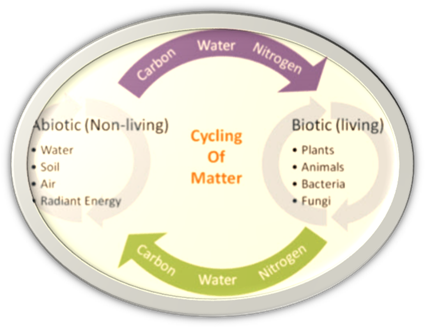
Unit Overview
In the last
unit, you learned about how energy is transferred through the living (biotic)
part of an ecosystem. In this unit, you will learn about how some of the most
important types of matter, that are needed to support life, are recycled and
reused within an ecosystem. Each substance we discuss in this unit moves from
abiotic parts of an ecosystem into biotic portions of an ecosystem and back
again. The types of matter that will be discussed in this unit are water, carbon, nitrogen, and phosphorus.
Since each of these types of matter travel from nonliving parts of the
environment into living parts and back again they are sometimes referred to as biogeochemical cycles.
Water Cycle
Water is
extremely important to all living things. Since cells are made up of about
70-90% water, and organisms need water environments for many biochemical
reactions, living things could not survive without water. The availability of
water is an important characteristic for a terrestrial ecosystem and
biodiversity. However, most of the water on Earth is not found in organisms,
but does travel through them in the water
cycle, also known as the hydrologic cycle.
 Most of the water on Earth is found
in bodies of water, such as oceans,
lakes, rivers, streams, and ponds. Some water passes into the soil through the
process of infiltration, which then
can move down further through the soil and its layers by gravity in a process
known as percolation. As water passes
through the soil, it is then stored in underground cracks and spaces in soil,
sand and rock. The water found underground is known as groundwater. From the Earth‘s surface, water evaporates into the atmosphere. The other way water can be released
into the atmosphere is through the process of transpiration. Transpiration is a process in which the leaf of a
plant releases water into the air in the form of water vapor. Animals also
release water into the atmosphere as water vapor through breathing, sweating
and excreting. However, animals release a much smaller amount of water vapor as
compared to plants.
Most of the water on Earth is found
in bodies of water, such as oceans,
lakes, rivers, streams, and ponds. Some water passes into the soil through the
process of infiltration, which then
can move down further through the soil and its layers by gravity in a process
known as percolation. As water passes
through the soil, it is then stored in underground cracks and spaces in soil,
sand and rock. The water found underground is known as groundwater. From the Earth‘s surface, water evaporates into the atmosphere. The other way water can be released
into the atmosphere is through the process of transpiration. Transpiration is a process in which the leaf of a
plant releases water into the air in the form of water vapor. Animals also
release water into the atmosphere as water vapor through breathing, sweating
and excreting. However, animals release a much smaller amount of water vapor as
compared to plants.
As water
collects in the atmosphere it may begin to undergo condensation (forming clouds or fog). Condensation is the process
of water vapor changing into liquid water droplets. The water will eventually
leave the atmosphere, depending on temperature and pressure, as precipitation, and return to Earth’s
surface. Precipitation may be in the form of rain, snow, hail, or sleet.
As precipitation reaches Earth’s surface, the water moves across the surface as
runoff. Runoff is the flow of water
over a surface of land, moving from areas of higher elevation to areas of lower
elevation, eventually collecting in a body of water. As runoff occurs, some of
the water will evaporate, some will seep into the ground, while the remaining
runoff water collects in larger bodies of water.
Visit the
link below for an interactive diagram of the water cycle:
http://water.usgs.gov/edu/watercycle-kids-adv.html
Complete the “water cycle worksheet”
by clicking on the link below.
Carbon Cycle
Carbon and
oxygen are very important for all life on Earth. If you recall, you learned
about photosynthesis (unit 9) and cellular respiration (unit 10). Both
processes required and utilized oxygen and carbon. The cycles of carbon and
oxygen are also closely related such that they use the same cycle. The Carbon
Cycle is sometimes referred to as the Carbon and Oxygen Cycle.
|
Carbon Cycle and Oxygen Cycle
Relationship |
|||
|
Photosynthesis |
Cellular
Respiration |
||
|
Carbon Cycle Summary |
|||
|
Removes
carbon dioxide (CO2) from the atmosphere. |
Produces
the sugar – glucose (C6H12O6) |
Consumes
the sugar - glucose (C6H12O6) to make ATP |
Produces
carbon dioxide (CO2) and releases it into the atmosphere |
|
Oxygen Cycle Summary |
|||
|
Produces
oxygen (O2) by way of splitting water and releases the oxygen into
the atmosphere. |
Removes
oxygen (O2) from the atmosphere to make ATP. |
||

Photosynthesis and cellular
respiration exchanging oxygen and carbon dioxide between organisms and the
environment is known as respiration.
There are
other ways that carbon dioxide can be introduced to the atmosphere. Combustion is another way of releasing
carbon dioxide into the atmosphere. Combustion is the burning of a substance
that is living or was living. Cutting a tree down and burning it is an example
of combustion of a living organism. Burning a fossil fuel (remains of dead
plants and animals), as in a car engine or industrial factory, is another
example of combustion, but of burning organism remains. Both methods of
combustion release carbon dioxide into the atmosphere. Another way of releasing
carbon dioxide is in death and
decomposition. As decomposers break down dead organisms carbon dioxide is
released in the process.
As you
should notice, there are three ways of introducing carbon dioxide into the
atmosphere, but only one way of removing carbon dioxide from the atmosphere.
This
accumulation of carbon dioxide in the atmosphere is believed to have an effect
on global temperature. Carbon dioxide, as a “greenhouse gas”, has the ability
to trap heat, therefore, as carbon dioxide builds in the atmosphere, the
temperature of the atmosphere begins to increase. Many use this idea to support
the idea of global warning.
Visit the
link below for a video about the carbon cycle and the effects of carbon dioxide:
http://www.epa.gov/climatechange/kids/basics/today/carbon-dioxide.html
Complete the “carbon cycle worksheet” by clicking on the link below.
Nitrogen Cycle
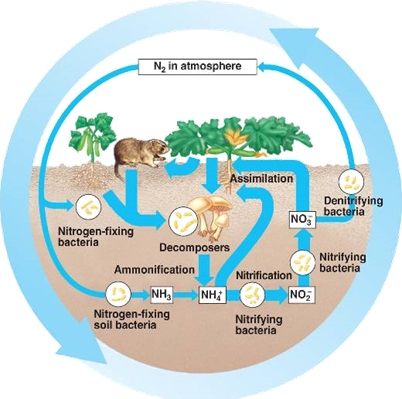
Sometimes
students can easily understand why we need water, oxygen, and carbon dioxide to
cycle. Most of us can see the importance of those substances in our existence.
Interestingly, all living organisms need nitrogen also. All living organism,
including us, need nitrogen to make proteins and nucleic acids. Remember how
proteins are made of amino acids and nucleic acids are made of nucleotides. The
twenty different amino acids require nitrogen as one of their atoms, as well as
the nitrogenous bases of the nucleotides, therefore we need nitrogen to cycle.
Another interesting idea is that the atmosphere is made of about 78% nitrogen
gas (N2). The problem is that most organisms cannot use nitrogen in
that form, most organisms need it changed into a different form.
The process
of converting nitrogen gas (N2) into the usable form nitrate is
called nitrogen fixation. Organisms
require bacteria found in the soil to convert nitrogen gas into a usable form.
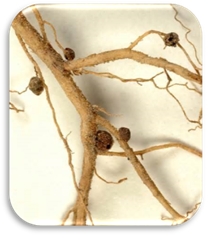
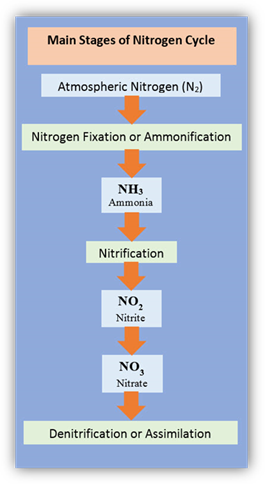 Nitrogen-fixing
bacteria live in the soil and in the roots of some plants. The types of plants
that some of these bacteria live in are known as legumes, such as beans, peas, and clover. The roots of the legumes
will have small swellings containing bacteria on their roots, the swellings are
called root nodules. The legumes and
bacteria that live with them have developed a mutualistic relationship in which both organisms benefit. The
bacteria supply the plant with usable nitrogen and the plant provides the
bacteria with an airtight place to live while supplying the bacteria with
carbohydrates (sugar from photosynthesis). Any extra nitrogen produced is
released into the soil. Nitrogen may also be fixed by lightning, but more
nitrogen happens to be fixed by bacteria. Nitrogen may also be fixed by burning
fuels.
Nitrogen-fixing
bacteria live in the soil and in the roots of some plants. The types of plants
that some of these bacteria live in are known as legumes, such as beans, peas, and clover. The roots of the legumes
will have small swellings containing bacteria on their roots, the swellings are
called root nodules. The legumes and
bacteria that live with them have developed a mutualistic relationship in which both organisms benefit. The
bacteria supply the plant with usable nitrogen and the plant provides the
bacteria with an airtight place to live while supplying the bacteria with
carbohydrates (sugar from photosynthesis). Any extra nitrogen produced is
released into the soil. Nitrogen may also be fixed by lightning, but more
nitrogen happens to be fixed by bacteria. Nitrogen may also be fixed by burning
fuels.
Decomposers
break down dead material and release nitrogen in the form of ammonia (NH3)
in a process called ammonification.
Ammonification provides another way of reintroducing nitrogen back into the
ecosystem. A second type of nitrogen-fixing bacteria take this ammonia (NH3)
and convert it into nitrites (NO2) and nitrates (NO3).
The process of converting ammonia into nitrites and nitrates is known as nitrification. After nitrification, in
the effort to make nitrates (NO3), plants now have a usable form of
nitrogen. The process in which plants absorb the nitrates (NO3) that
are produced is called assimilation.
Leftover nitrates in the soil will be broken down by a third type of bacteria
in the soil, which will convert the nitrates back into nitrogen gas to be
released into the atmosphere once again. The process of converting the nitrates
back into nitrogen gas is called denitrification.
Notice that animals are not mentioned in this cycle, except under
decomposition. Animals acquire the nitrogen they need by consuming the plants
which absorb the nitrogen from the ground.
Complete the “nitrogen cycle
worksheet” by clicking on the link below:
Phosphorus Cycle
Phosphorus is another substance that
needs to be cycled for all living things in an ecosystem. Phosphorus is needed
by organisms for nucleic acids, cell membranes, and bones. This substance, just
like the others we have already mentioned, go from the physical environment to
living organisms and back to the physical environment. Phosphorus cannot be
found in the air as a gas. Phosphorus is normally found in soil and rock as
calcium phosphate in the form of a solid which is dissolved in water. When
dissolved in water, the phosphorus can seep into the ground for plants to
absorb, or it will wash into bodies of water by way of runoff. The phosphorus cycle
is one cycle where the atmosphere does not play a major role in the movement of
a substance.
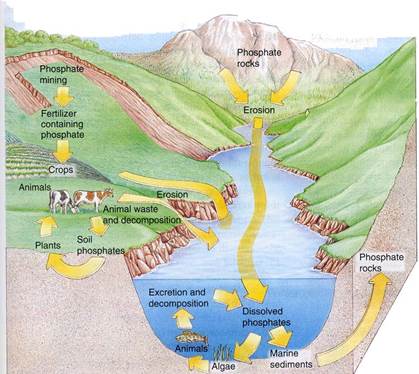
Usable phosphate found in the ground
is absorbed by plants. Animals, including us, eat the plants to obtain the
phosphorus. When the animals and plants die and decompose the phosphorus
returns to the ground.
The phosphorus cycle moves slowly
through the physical environment (soil and oceans), but quickly through the
living parts (plants and animals) of the ecosystem. The phosphorus cycle is one
of the slowest biogeochemical cycles.
In
the following video all aspects of the phosphorus cycle are described.
Phosphate in fertilizer runs off into waterways, causing algal blooms or
eutrophication.
![]() Requirements for
Life: Phosphorus
Requirements for
Life: Phosphorus
Discovery Education-Additional
Resources:
The Water Cycle Skill Builder from Discovery Education
presents an animation of each phase of the water cycle: evaporation,
condensation, precipitation, and infiltration.
The Carbon Cycle Skill Builder Traces the flow of
carbon through the atmosphere, the biosphere, the hydrosphere, and the
geosphere. Also defines such terms as photosynthesis, assimilation,
respiration, diffusion, and combustion.
The Nitrogen Cycle Skill Builder identifies the phases
in the nitrogen cycle including assimilation, decomposition, and nitrification.
Also examines the problems that occur when the cycle breaks down, like algal
blooms and acid rain.
Click on the
Quizlet icon below to access the
quizlet.com vocabulary flash cards. Review the vocabulary before completing
your assessment.
 Now answer
questions 1 through 20.
Now answer
questions 1 through 20.
